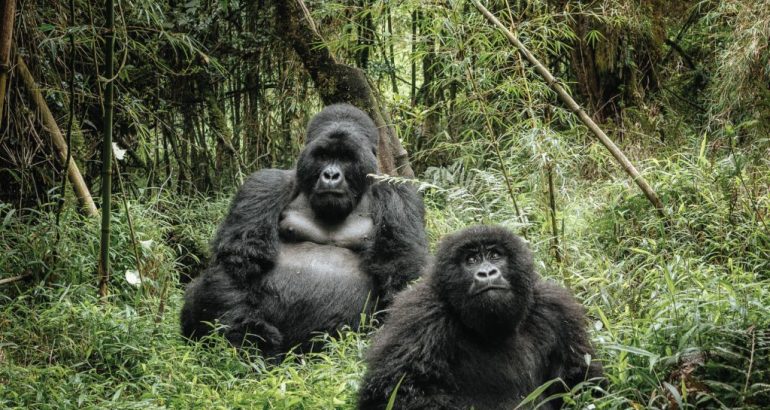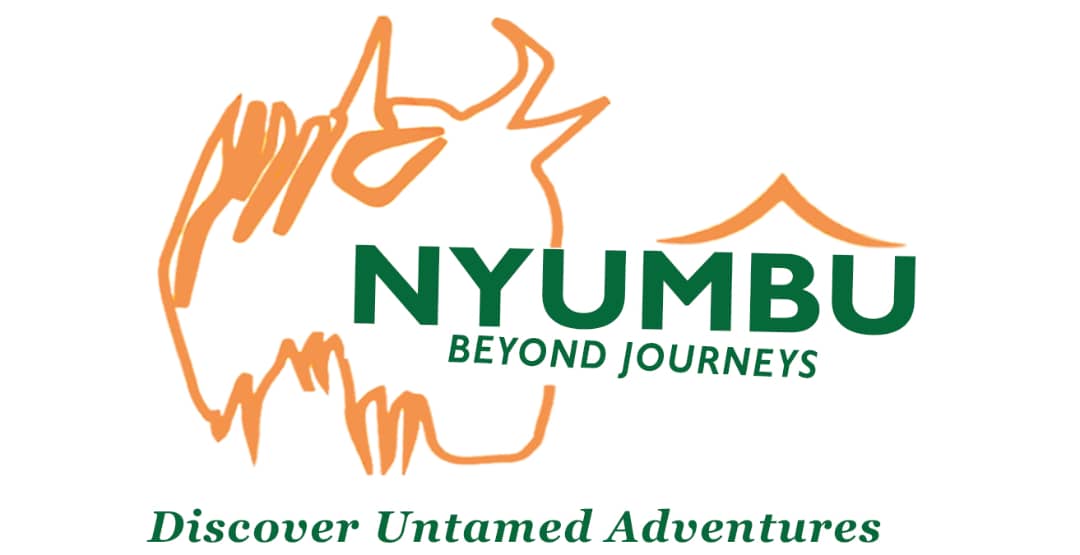
About
We pride ourselves on our passion for East Africa, her animals, wild spaces and Culture, amazing people.

© Copyright 2025 Nyumbu Beyond Journeys. All Rights Reserved

The foliage parts on a winding trail to reveal 200 kilograms of muscle, covered by a thick coat of silver and black hair, sitting amongst the thickets of a vast and unforgiving forest. You make eye contact, but there is no threat. These beasts are docile if you keep your distance.
1. Introduction to Bwindi
Uganda’s most important national park
Even if Bwindi Impenetrable National Park was not home to the Mountain Gorilla, its remoteness, natural beauty and enthralling biodiversity would attract visitors. But it is those magnificent great apes that have made Bwindi Uganda’s single most important tourist destination.
Coming face to face with mountain gorillas in their natural habitat is one of the most powerful and humbling wildlife encounters possible. You can always spot trekkers who are returning from having been with the gorillas: even the strong and silent types are grinning and chattering like birds.
2. Gorilla Trekking in Bwindi
Classic gorilla trekking, a once-in-a-lifetime wildlife encounter
Departing from one of the four trailheads on the perimeters of the forest (Buhoma, Nkuringo, Rushaga, and Ruhija), you join a group of a maximum of eight other visitors for a guided trek into the forest in search of one of 11 habituated gorilla families.
Led by experienced, specialised Uganda Wildlife Authority guides, you will be introduced to the ecology of the forest and the changing landscape as you trek to the gorillas. Your guides are in communication with the team of trackers who will have been shadowing the gorillas since daybreak. The trackers direct your guides to bring you to the gorillas.
You should be prepared to walk through a challenging terrain of steep ridges and valleys, following animal paths through tangled undergrowth for about three hours to reach this point. Although sometimes contact can be made after 45 minutes and other times six hours.
Once contact has been made, you have up to one hour in which to observe the gorilla family from a distance of 7 metres. However, you should also be prepared for relaxed mums or inquisitive young to close this gap considerably! The trackers will remain in charge of the contact, telling you what to do in order to remain safe and enjoy the experience to the full.
The number of gorillas permits each day is strictly limited and so the peak season months of June to September and January and February sell out well in advance of travel. It is therefore recommended that you plan your visit about a year in advance, if not earlier. Gorilla permits are non-refundable, but if you trek and do not see a gorilla, the Uganda Wildlife Authority will refund 50% of the permit cost. This happens very rarely.
Gorilla habituation experience, for the most enthusiastic among you
Visitors often ask about the difference between tracking the mountain gorillas in Uganda and Rwanda. One of the answers is that over the last few years, Uganda has provided an incredible opportunity to join a gorilla habituation team and spend up to four hours in the company of one gorilla family.
This opportunity costs $1,500 per person, but with only six trekkers in a group, it is an intense and unforgettable experience, perfect for those with a passion for gorillas or the urge to capture the perfect photographic record of the experience.
It is not right for everyone, even if the cost is not an issue. Four hours is a long time to remain quiet and observant in a small area of forest. We humans find it incredibly difficult to maintain concentration for more than an hour. However, for some, it can be an ultimate travel highlight.
3. The Four Trailheads
Habituated families can be accessed from four trail heads: Buhoma, Ruhija, Rushaga and Nkuringo. Each trail head has its own characteristics, families and levels of difficulty.
The trailheads serve as launch points for treks to 11 fully habituated (and three semi-habituated) gorilla family groups. The standard treks depart in the morning and include up to one hour observing the gorillas from a distance of about seven metres.
The treks can be quite challenging, and you need to be prepared to trek for up to 6 hours, although most sightings take place within 2-3 hours.
Buhoma
Gorilla tracking began here in 1993. It has the greatest number of accommodation options and is the home of the park’s HQ. If you are coming into Bwindi from the north, the chances are you will be staying at Buhoma.
Arguably, the topography around Buhoma provides some of the more accessible gorilla treks, especially as the Rushegura family is known to be found relatively close to the village (occasionally thrilling visitors to Gorilla Forest Camp).
Buhoma is also home to inspiring non-governmental organisations like Ride 4 a Woman, Village Trumpets Foundation, plus local craftsmen, providing interesting and often inspirational experiences outside the forest.
Ruhija
45 kilometres from Buhoma, Ruhija has been said to be one of the most beautiful gorilla tracking areas.
At 2,340 metres, it is also one of the most challenging. Opened for tracking in 2008, the local roads have now been improved to the extent that visitors often stay in Buhoma, enjoying the greater range of accommodation options, and then track in Ruhija where three gorilla groups are now available.
Buhoma and Ruhija are the two trailheads serving the north of the park. Buhoma’s superior range of accommodation means it’s often the trailhead of choice if you’re coming down from the north.
Rushaga
Rushaga is the first of the trailheads in the south of the park.
There are five gorilla groups available in Rushaga, making 40 permits available daily. Additionally, six permits are available for the gorilla habituation trek. The terrain is more open here, providing stunning views of the mountains, rather than enveloping trekkers in forest, making it easier going than Ruhija.
While there are local accommodation options, Rushaga is also accessible to trekkers staying in Nkuringo, around Lake Mutanda, or even Kisoro.
Nkuringo
Opened in 2004, Nkuringo is found diametrically opposite to Buhoma in the remote south of Bwindi. The trailhead is at an altitude of 2,100 metres on the Nteko Ridge, 600 metres above the Kashasha River valley where the Nkuringo gorilla group like to roam. This makes for a steep descent at the beginning of a trek and a very challenging return hike.
There is no doubt that Nkuringo is the most difficult tracking destination of the four. But it is beautiful with stunning panoramic views of the Virunga Volcanic Range. A stay here also provides access to local farming communities, a Batwa experience and the wonderful lakes Mutanda and Bunyonyi.
4. When to visit Bwindi Forest
You can visit the gorillas year-round, but be prepared for rain
Due to Uganda’s equatorial position and an increasingly variable climate, the weather in Bwindi Impenetrable National Park can be unpredictable, and you should always be prepared for rain when visiting Bwindi.
However, the heaviest rainfall normally occurs from mid-March to the end of May and then again at the end of September through to November. While the rains in March to May are often short, those in September to November are more often characterised by hours of soft drizzle.
Gorillas can be tracked at any time of year, but it does become harder when the trails are mud-slides and water is running down your neck, soaking you through. So, the most popular times to track the gorillas is the drier months of June to mid-September and December, January and February.
But don’t discount the ‘rainy season’. Permits are easier to come by at relatively short notice and there is something exhilarating about sitting, mud-covered and uncaring, among a group of gorillas, feeling like you are the only people in the forest.
5. Beyond the Gorillas
The mountain gorilla symbolises Bwindi, but it is not the whole story
The physical variation, biodiversity, natural beauty and fascinating cultures found in and around Bwindi Impenetrable National Park make it a wonderful place to visit. While the average stay is only two or three nights and the prime reason to visit is to track the gorillas, there is much more to do, and a longer stay is worthwhile.
Bwindi offers some fantastic forest walks, the wildlife is staggering in its breadth and ranges far beyond just the gorillas, and spending time with the people of Bwindi, learning their history and relationship with the forest is captivating.
Forest treks, meditative walks through the gorilla’s backyard
Guided treks are available from each trailhead. One of the most popular is the transect from Buhoma to Nkuringo (or vice versa) where you walk from one side of the forest to the other.
The trek takes between 3 or 5 hours, depending on the route taken – although slower walkers may end up taking much of a day. There is no rush; you move slowly through the forest, taking in the sights and sounds, observing the changes; stopping just to enjoy the sense of peace.
It is also sensible to keep an eye open for familiar tracks, steaming piles of dung and a black shape in the foliage. This is gorilla territory after all.
Wildlife in Bwindi, it’s not just gorillas lurking in the bushes
Bwindi’s altitudinal span, antiquity, remoteness, and flora have contributed to creating one of Africa’s most biodiverse forests. Bwindi is home to over 120 mammal species, more than any other Ugandan park with the exception of Queen Elizabeth National Park. There are more than 160 tree and 100 fern species.
Of the mammals, the mountain gorilla is the most famous. However, another 10-primate species are present including chimpanzees (unhabituated), olive baboon, black-and-white colobus, L’Hoest’s monkey, red-tailed monkey and blue monkey. There is a seldom-seen herd of over 30 ‘forest’ elephants in the south-east of the forest and six antelope species: bushbuck and five duiker species.
Even though Bwindi has very little wetland habitat, it still holds about 350 species of birds. Of these, 23 species are endemic to the Albertine Rift and at least 14 species are recorded nowhere else in Uganda. Butterflies add colour and a good indication of the ecological health of a forest. Bwindi has at least 200 species, plus an incredible range of reptiles and amphibians.
6. People of Bwindi
Alongside the primates and the birds, it is important to remember that people have as important a part to play in the story of Bwindi as the gorillas.
Providing the local people with access to opportunity to improve their lives and tell their story will go a long way to ensuring the preservation of the forest and its inhabitants for years to come.
Happily, a visit to Bwindi does include the opportunity to discover the story of the Batwa people, original human inhabitants of the forest, and the Bakinga, farmers from the forest fringe, supporting sustainable development projects as a result.
You can also explore the village of Buhoma, meeting local artisans, observing their methods.
7. Accommodation Options
The majority of the lodges are found in Buhoma. Over the years, the simpler properties like Engagi Lodge and Haven Lodge have developed loyal followings. In the mid-range, Mahogany Springs and Buhoma Lodge are reliable favourites, while Gorilla Forest Camp and Volcanoes Bwindi Lodge are two of the best options available.
Properties in Ruhija and Rushaga are used less often. While they are closer to the trail heads, feedback on the quality of accommodation and service is often mixed. In the far south, the beautiful Clouds Mountain Gorilla Lodge provides stylish, luxury accommodation, with Nkuringo Lodge providing a slightly simpler, but swiftly improving, alternative.
8. Getting There
For many years the journey to Bwindi took at least two long days driving on bad roads. But times have changed, and while it does still take over 10 hours on a good day to drive from Entebbe to Bwindi, it is also possible to fly to one of two airfields, Kihihi (for the north) and Kisoro (for the south of the forest), cutting the journey to a flight of about 90 minutes and a short drive of about 1.5 hours. The flights operate on a daily schedule, combining with other destinations within Uganda.
The drive from Ishasha, the southern sector of Queen Elizabeth National Park, takes about 2 hours and Lake Mburo National Park can be reached in 5-6 hours.
It is also becoming increasingly popular to drive from the south of Bwindi across the border into Rwanda, either to explore the neighbouring country or continue to Kigali to fly home. The journey from Nkuringo in southern Bwindi to the Rwandan border takes about two hours and the second leg to Kigali about 3 hours, depending on local conditions.
If you have booked your adventure with us, all transfers will be arranged for you.
9. Geography, Geology & History of Bwindi
For the history buffs
The forest has existed for over 25,000 years and was once part of a much larger expanse that reached the lower slopes of the Virunga Mountains until agricultural expansion in the Kisoro area 500 years ago.
In 1932, the 207 square kilometre Kayonza and Kasatora Crown Forest was created to protect the forest. 32 years later, in 1964, the national park was created, and the area designated as a gorilla and wildlife sanctuary, expanding the protected area to its current size. In 1994 Bwindi was declared a UNESCO Natural World Heritage Site due to its biodiversity and the high number IUCN red-listed (the most threatened) species found there.
Geography & Geology of Bwindi
Bwindi Impenetrable Forest National Park is 331 square kilometres of tropical forest, steep hills and deep valleys abutting the border with the Democratic Republic of Congo in the southwest of Uganda.
Occupying the edge of the Western Rift Valley, its geology is comprised of quartzite, pre-cambrian shale phyllite, granite, quartz and schist. The altitude ranges from 1,160m – 2,607m above sea level with about 60% of the park having an elevation of over 2,000 metres. The lowest area of the park is found at its most northern tip and the highest is Rwamunyonyi Peak (2,607m) on the eastern edge of the park.
From these highlands, five major rivers begin their descent into Lake Edward, Mutanda and Bunyonyi fed by annual rainfall of between 1,400 to 1,900 millimetres.
10. The Mountain Gorilla
About this great ape
In 1903, on the slopes of Mt Sabyinyo in what is now Rwanda, German army officer Captain Friedrich Robert von Beringe shot two gorillas, thereby introducing zoologists to the mountain gorilla.
Today, a small, but stable, population exists, split between the Virunga Volcanoes of the DRC and Rwanda and the forests of southwestern Uganda.
The mountain gorilla is a very large, very black, barrel-chested ape, densely-furred (to protect against the cold) with a broad face. They are found in mountain and subalpine environments, enjoying dense tangles of herbaceous growth in valley bottoms, old clearings and around landslides.
The restricted environment means that the mountain gorilla has a more restricted diet than its lowland counterpart, feeding mainly on bamboo, but also the leaves, shoots and stems of over 140 other species, plus vines and wild celery.
They are highly sociable and exist in groups of between 5 to 50 individuals. The group will have one dominant ‘silverback’, an adult male above the age of 13 (when silver hairs begin to grow in the saddle of the back), sometimes assisted by subordinate silverbacks. The silverback eats first, but is also responsible for the defence of the group, a trait that enables gorillas to spend more time on the ground than the other great apes. When the silverback dies, his group will split.
Groups forage throughout their home range, but do not defend it. When two groups move close to one another, they will avoid contact in order to reduce the risk of conflict. They spend much of the day resting, which provides such a great opportunity for trackers to join and observe the group.
Reproduction occurs slowly, with adult females over the age of eight producing on average one young every four years and often no more than six in a lifetime. The young have an extended childhood and are carefully cared for and fiercely protected by both the females and the dominant silverback. If a silverback dies or is pushed from the group, then the incoming dominant male will often kill any young gorillas, which means that a dominant silverback is always protected by the females when threatened.
Conservation success story
In May 2018, the results of the most recent census of the mountain gorilla population in the Virunga Massif – the 174 square miles of the conjoined protected areas in Uganda, Rwanda and the DRC – was released. The result was an increase in the total population from the 880 recorded in 2011 to over 1,000 recorded individuals.
The increase is excellent because it demonstrates that not only is the forest habitat being protected, and poaching combated, but that the human contact resulting from the habituation treks is not negatively affecting the gorilla’s health or ability to reproduce. In short, the news confirmed that the most important reason to visit Bwindi is to play your part in the long-term protection of the world’s greatest ape.
Join us on a gorilla odyssey across to Bwindi Impenetrable for a lifetime adventure @Nyumbu Beyond Journeys
We pride ourselves on our passion for East Africa, her animals, wild spaces and Culture, amazing people.

© Copyright 2025 Nyumbu Beyond Journeys. All Rights Reserved
